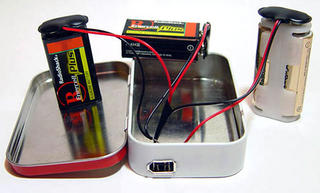One Possible End of the 'End User'

 As we spend more time communicating, playing, and working in the digital world, our expectations and ways of acting will transfer to the physical world. Digital objects are, above all, plentiful, easily copied and easily shared. And they are beautifully malleable. We transform them, recombine them, share them some more. Photos are Photoshopped, music is remixed, code is developed co-operatively, web applications with open APIs are mashed together.
The digital world is, in part by its nature and in part by thoughtful design, flexible. But the physical world not so much; by comparison it seems frustrating in its intractable and resolute thinginess. Physical things don’t duplicate with the right keystrokes, can’t be instantaneously shot around the world, and command + Z never fixes them.
We want to treat physical objects like digital objects. And designers should oblige. But how?
Part of the answer lies in one of the more troubling aspects of our consumer-driven culture: more and more things appear everyday. Like the digital objects, physical objects are becoming almost absurdly plentiful. But they don’t delete into nothingness. Things stay around. Jay Samit of Sony Mobile Connect has estimated that four-hundred million cell phones will be thrown out this year.
It’s as if the plenitude of things, which should make it less likely that we need to make anything ourselves, is instead inspiring people to do just that. Physical things, like digital objects, are being remixed, recombined, collaboratively re-invented. It’s as if the science-fiction post-apocalyptic hacked and re-wired world of Road Warrior arrived a little early.
The first signs of this thinking might be found in the new popularity of the crafting DIY movements. Make Magazine, which provides instructions for building and modifying everything from kites to cars, has been immediately successful. But more interesting, and more promising, are the labs that bring people together with different areas and levels of expertise. Of course, we aren’t all engineers, we don’t all have complete toolsets, some of us don’t even have much space to work in. So it seems as if DIY not every end user can become a mid-point user.
But places like Squid Labs, Eyebeam, Sparqs , and the PIE Network all rely on shared knowledge and space: collaboration and cooperation are essential. In fact, Squid Labs recently launched instructables.com, a site meant to document the how-to of projects and let those projects be freely shared (even if some of them require currently expensive fabrication tools).
It’s possible that these places suggest an interesting model for a future type of space and interaction—the neighborhood lab, a place to drop off old products, assemble custom tools, create one-off devices, and educate children who, because of the influence of the digital world, are more likely to think: I am going to change this.
Designers should pay attention to what is written in Make magazine and what comes out of places like Eyebeam. Products may be developed with an eye to these secondary markets and with new questions in mind: what potential life does this have outside of its intended and immediate use? What essential functionality does it encapsulate? What can be salvaged and used elsewhere?
The real icon of this sort of age might be the ubiquitous and simple Altoids mint tin, which has seen its range of re-use extend from holding rubber bands to housing iPod rechargers, serving as an emergency stove, and taking pinhole photographs. Of course it’s flexible because it has a simplicity that few consumer products can achieve, but it remains an admirable product in its possibilities and a clear lesson that re-use adds value for the both the users and producers.
As we spend more time communicating, playing, and working in the digital world, our expectations and ways of acting will transfer to the physical world. Digital objects are, above all, plentiful, easily copied and easily shared. And they are beautifully malleable. We transform them, recombine them, share them some more. Photos are Photoshopped, music is remixed, code is developed co-operatively, web applications with open APIs are mashed together.
The digital world is, in part by its nature and in part by thoughtful design, flexible. But the physical world not so much; by comparison it seems frustrating in its intractable and resolute thinginess. Physical things don’t duplicate with the right keystrokes, can’t be instantaneously shot around the world, and command + Z never fixes them.
We want to treat physical objects like digital objects. And designers should oblige. But how?
Part of the answer lies in one of the more troubling aspects of our consumer-driven culture: more and more things appear everyday. Like the digital objects, physical objects are becoming almost absurdly plentiful. But they don’t delete into nothingness. Things stay around. Jay Samit of Sony Mobile Connect has estimated that four-hundred million cell phones will be thrown out this year.
It’s as if the plenitude of things, which should make it less likely that we need to make anything ourselves, is instead inspiring people to do just that. Physical things, like digital objects, are being remixed, recombined, collaboratively re-invented. It’s as if the science-fiction post-apocalyptic hacked and re-wired world of Road Warrior arrived a little early.
The first signs of this thinking might be found in the new popularity of the crafting DIY movements. Make Magazine, which provides instructions for building and modifying everything from kites to cars, has been immediately successful. But more interesting, and more promising, are the labs that bring people together with different areas and levels of expertise. Of course, we aren’t all engineers, we don’t all have complete toolsets, some of us don’t even have much space to work in. So it seems as if DIY not every end user can become a mid-point user.
But places like Squid Labs, Eyebeam, Sparqs , and the PIE Network all rely on shared knowledge and space: collaboration and cooperation are essential. In fact, Squid Labs recently launched instructables.com, a site meant to document the how-to of projects and let those projects be freely shared (even if some of them require currently expensive fabrication tools).
It’s possible that these places suggest an interesting model for a future type of space and interaction—the neighborhood lab, a place to drop off old products, assemble custom tools, create one-off devices, and educate children who, because of the influence of the digital world, are more likely to think: I am going to change this.
Designers should pay attention to what is written in Make magazine and what comes out of places like Eyebeam. Products may be developed with an eye to these secondary markets and with new questions in mind: what potential life does this have outside of its intended and immediate use? What essential functionality does it encapsulate? What can be salvaged and used elsewhere?
The real icon of this sort of age might be the ubiquitous and simple Altoids mint tin, which has seen its range of re-use extend from holding rubber bands to housing iPod rechargers, serving as an emergency stove, and taking pinhole photographs. Of course it’s flexible because it has a simplicity that few consumer products can achieve, but it remains an admirable product in its possibilities and a clear lesson that re-use adds value for the both the users and producers.


0 Comments:
Post a Comment
<< Home